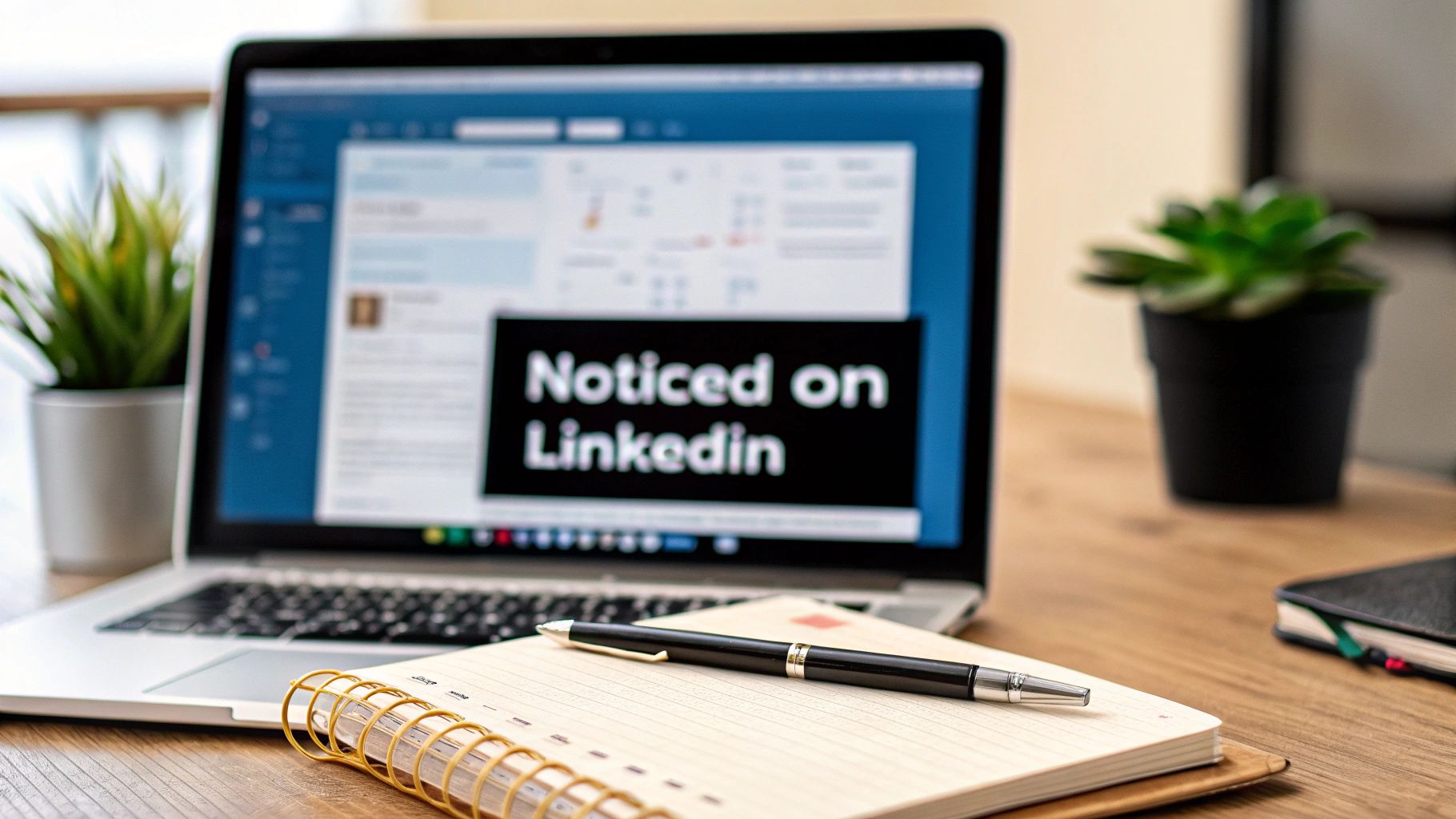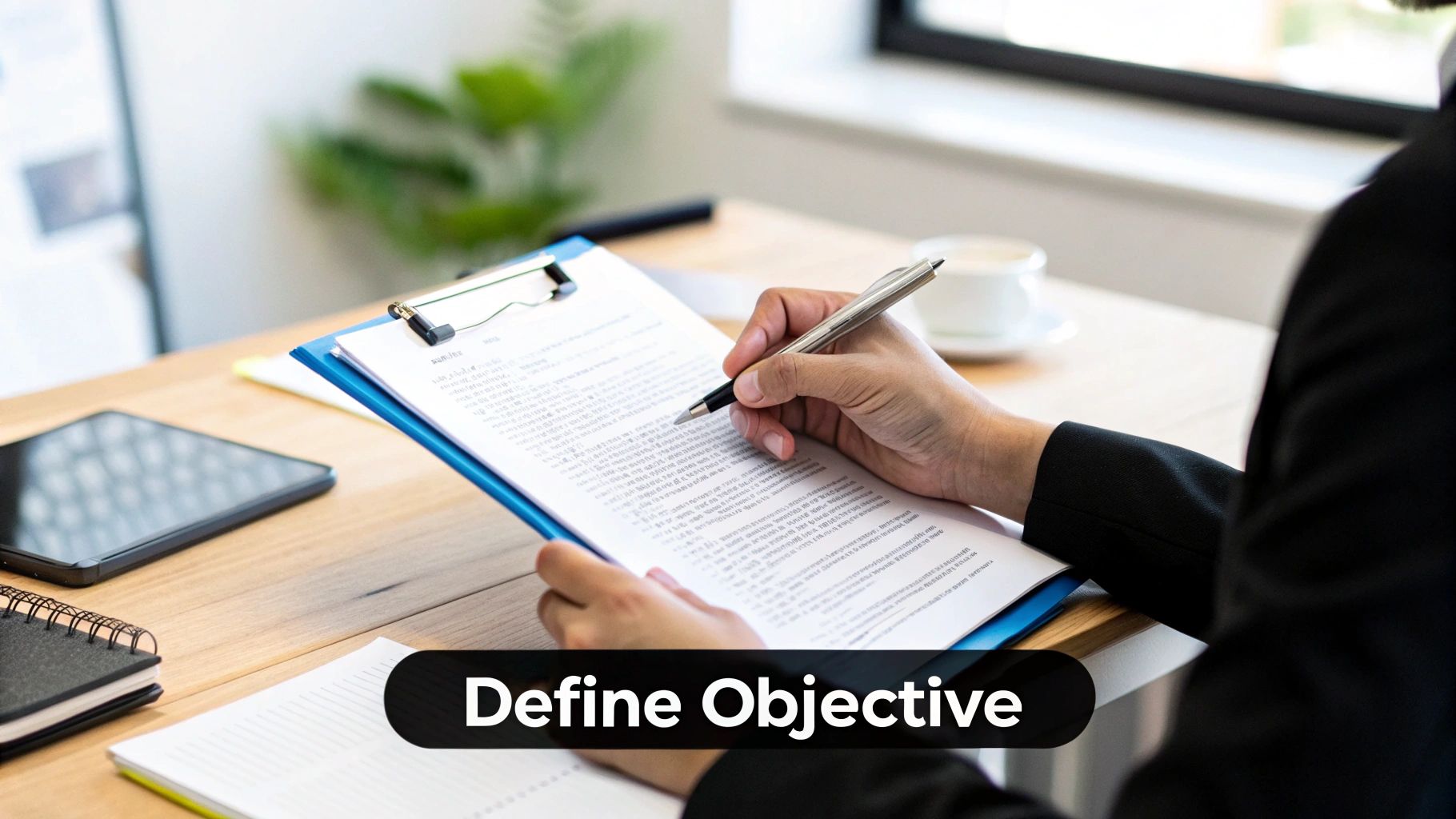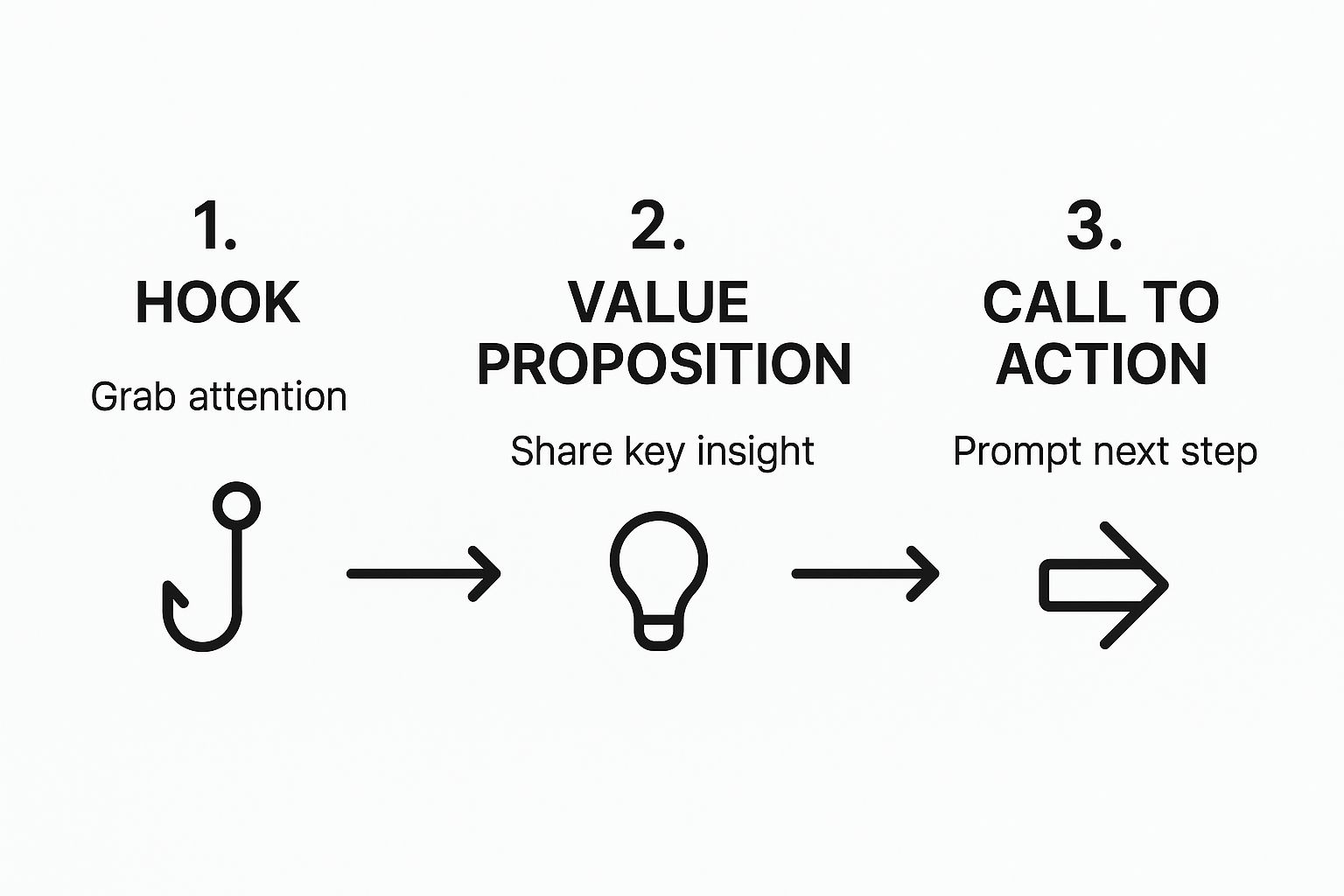
How to Make a Post on LinkedIn That Gets Noticed
Published on 2025-09-30
Anyone can throw a post up on LinkedIn. You just head to your feed, click "Start a post," type something out, and hit publish. Simple. But crafting a post that actually gets noticed? That’s a different game entirely. It’s about being strategic, not just active.
Why Bother Posting on LinkedIn, Anyway?
Before we get into the nitty-gritty of how to post, let’s talk about the why. A solid LinkedIn post is so much more than a quick update. Think of it as a small investment in your professional reputation. Each one sends ripples across a massive professional ocean, reaching people far beyond your immediate network.

When you see its potential, you stop just sharing and start creating content with a purpose. Consistent, thoughtful posts can turn your profile from a static resume into a living, breathing showcase of your expertise.
Build Your Authority and Personal Brand
Every single thing you share on LinkedIn adds a brushstroke to the portrait of your personal brand. It's your chance to show what you know, share your unique point of view, and position yourself as an authority in your field. When you consistently provide value, people notice. Your network, and the people in their networks, start to see you as the go-to person for your niche.
Of course, this doesn't just happen overnight. If you want to move from random updates to purposeful content, it pays to have a plan. Digging into a good LinkedIn content strategy can help you build the kind of authority that gets you noticed.
Grow Your Professional Network
LinkedIn’s growth is staggering. Since it launched way back in 2003, it has exploded, officially crossing the 1 billion user mark in early 2025. It’s not slowing down, either—the platform adds about two to three new members every second.
Think of every post as a mini networking event. When people like, comment on, or share your content, it pops up in their networks' feeds. That’s how you get introduced to new connections, potential clients, and future collaborators you’d never meet otherwise.
Posting regularly keeps you on people's radar and opens doors. It’s all about starting conversations that can lead to real, meaningful professional relationships.
Writing a Hook That Stops the Scroll
You've got about three seconds. That's it. That's the entire window you have to stop someone from scrolling past your post on their LinkedIn feed. This is why your opening line isn't just important; it's everything.
A killer hook is the difference between your post getting read and getting ignored. Even the most brilliant insights will vanish into the digital noise if the first sentence doesn't land.

That first sentence has one job: make someone click "...see more." Your goal is to poke their curiosity, stir up an emotion, or drop a surprising fact that makes them hit the brakes.
Hooks That Actually Work
So, what makes a good hook? I’ve found the best ones almost always tap into basic human psychology—they trigger curiosity, touch on a relatable struggle, or even court a little controversy. It pays to play around with a few different styles to see what your own audience responds to.
Here are a few of my go-to approaches:
- The Provocative Question: Kick things off with a question that gets the gears turning. Something like, "What's the worst career advice you ever received?"
- The Contrarian Take: Challenge a piece of conventional wisdom. An opener like, "Everyone tells you to find a mentor. I think that's a mistake..." is bound to get some attention.
- The Shocking Stat: Numbers that jolt people are fantastic scroll-stoppers. For example, "Did you know only 8% of people actually stick to their New Year's resolutions? Here's why."
- The Personal Story: Start right in the middle of a relatable moment. "I completely bombed my first big client presentation. It was humiliating, but it taught me three things..."
A great hook does more than just earn a click. It sets the stage for the entire post, making a promise to the reader that their attention will be rewarded.
If you really want to go deep on this, there are some powerful hook strategies out there. Even though this resource is focused on video, the core psychological principles apply perfectly to written posts, too.
Here's a pro-tip: Don't just write one hook. Write the entire post first. Once you know exactly what your core message is, go back and brainstorm at least three different opening lines. Read them out loud. Which one would make you stop and read? Pick the one with the most punch. This single habit can completely change how your posts perform.
How to Structure Your Post for Easy Reading
A giant wall of text is a surefire way to make someone scroll right past your brilliant ideas. When it comes to writing a great LinkedIn post, how you structure it is just as important as what you say. The whole point is to make your content look inviting and scannable.
The biggest trick in the book? Short, punchy paragraphs. I'm talking one or two sentences, max. This simple change creates a ton of white space, instantly making your post feel more like a conversation and less like a chore to read. It literally guides the reader's eye down the page, keeping them engaged.
Create a Clear Path for the Reader
Think of your post's structure as a simple three-act play: a hook, the main point, and a conclusion. This visual guide breaks down that essential flow.

A successful post isn't just a block of text; it's a journey. It starts by grabbing attention, moves on to delivering real value, and wraps up with a clear next step for your reader.
Beyond short paragraphs, formatting is your secret weapon for breaking up the text and making your key points pop. This helps people digest complex ideas without having to work too hard.
- Bullet points are fantastic for listing tips, takeaways, or benefits. They signal to the reader that this is important, scannable information.
- Numbered lists are your go-to when you're explaining a step-by-step process or ranking items. They create a logical flow that's super easy to follow.
To really nail this, it helps to understand the core parts that make a post work. I've broken them down here.
Core Elements of a High-Impact LinkedIn Post
This table shows the essential components that every engaging LinkedIn post should have, from the opening line to the final sign-off.
| Element | Purpose | Best Practice Example |
|---|---|---|
| Hook | Grab attention in the first 1-2 lines. | "90% of startups fail for one simple reason. It's not what you think." |
| Body | Provide value, insights, or a compelling story. | Use short paragraphs, data points, and bulleted lists to explain your main idea. |
| Formatting | Improve readability and guide the reader's eye. | Add line breaks between every 1-2 sentences. Use emojis or bold text sparingly to highlight key points. |
| CTA | Prompt a specific action or conversation. | "What's the one piece of advice you'd add? Drop it in the comments below!" |
Putting these pieces together thoughtfully is what separates a post that gets ignored from one that gets noticed.
Remember, people on LinkedIn are scrolling fast. Your job is to structure your post to respect their time and make your key points impossible to miss.
Mastering these simple formatting techniques is a huge leap forward. If you want to go even deeper, check out our complete guide on how to properly format LinkedIn posts. It's packed with more advanced tips to make your content truly stand out.
Finally, don't forget to guide your readers. Every post should end with a clear, simple call-to-action (CTA). Ask a question, invite them to share their thoughts, or point them to a useful resource. This is how you turn passive readers into an engaged community.
Choosing Visuals and Hashtags That Work
Let’s be honest, nobody stops scrolling for a giant wall of text. No matter how brilliant your ideas are, they’ll get lost in the feed without a good visual to catch someone's eye. Think of an image or video not as an add-on, but as a core part of your hook.
Posts with images simply get more love—more comments, more likes, more everything.

This doesn't mean you need a professional photoshoot. In my experience, authentic, behind-the-scenes shots often outperform polished, corporate stock photos. A simple infographic you whip up yourself or even a quick, insightful video can be more than enough to make your content stand out.
Crafting a Smart Hashtag Strategy
Think of hashtags as your post's secret weapon for discovery. They're what help you break out of your immediate network and find a new audience. But just throwing a bunch of them at the end of your post won't cut it. You need a strategy.
Here's a simple framework I use:
- Broad Hashtags: These are the big ones, like
#marketingor#leadership. They cast a wide net, but you're also competing with a ton of other content. - Niche Hashtags: Get more specific here. Think
#contentstrategytipsor#b2bmarketing. The audience is smaller, but they're far more likely to be interested in what you have to say. - Branded Hashtags: Create a unique tag for your company or personal brand, like
#autoghostwriter. It’s a great way to group your content and build a community.
My rule of thumb? Aim for a balanced mix of three to five relevant hashtags. This gives you solid visibility without looking like you're trying too hard. Just pop them at the end of your post to keep things clean.
For a much deeper dive into this topic, our guide on how to use hashtags on LinkedIn has you covered.
Making Every Second Count
Here’s a startling fact: even with 1.77 billion monthly visits, the average user only spends about 17 minutes per month on LinkedIn. That's a tiny window to grab someone's attention.
Your visuals and hashtags are your front-line tools for making an instant impression. You can dig into more of these fascinating user behavior stats on Sprout Social.
The Final Pre-Publishing Check
You've done the heavy lifting. The draft is polished, the visual is sharp, and you've got your hashtags lined up. But before you hit "Post," taking a few moments for a final once-over can be the difference between a post that lands well and one that falls flat.
This isn't just about catching last-minute typos. It's about making sure every piece of your post is working together to grab attention and start a real conversation.
Fine-Tune and Finalize
First up, think about who needs to see this. Is there anyone you mentioned or a company that inspired your thoughts?
Tagging: Go ahead and tag them! Bringing relevant people and companies into the discussion is a fantastic way to boost your reach. A quick mention can pull them right into the conversation. Just be thoughtful—randomly tagging a long list of influencers feels spammy and rarely works.
Proofreading: A final proofread is an absolute must. Read your post out loud; it’s the best way to catch clunky sentences that your brain might otherwise skip over. A quick run through a tool like Grammarly doesn't hurt either. Small mistakes can chip away at your credibility, so this step is well worth the time.
Think of this final check as setting your post up for success. It's less about chasing perfection and more about being intentional with every detail, from who you tag to when you publish.
Finally, let's talk about timing. Posting at 2 PM on a Saturday probably won't get you much traction. When are your ideal readers actually scrolling through their feeds?
While every audience is different, you can find some great starting points in our guide on the best time to post on LinkedIn. The key is to experiment. Test a few different time slots and see what gets you the most likes, comments, and shares. Over time, you'll discover the sweet spot for your specific network.
Common Questions About Posting on LinkedIn
Even the most seasoned pros have questions when it comes to the nitty-gritty of posting on LinkedIn. It's totally normal. Let's walk through some of the most common sticking points so you can post with confidence.
Think of this as your quick-start guide to the unwritten rules of the LinkedIn feed. Getting these right will help you focus on what really matters: creating great content.
How Often Should I Post on LinkedIn?
This is probably the number one question I get. The answer isn't about hitting some magic number every day. It's all about consistency over frequency.
Seriously, posting 2-3 high-quality, valuable posts per week is so much better than spamming your network with half-baked thoughts daily. This pace keeps you top-of-mind without becoming background noise. The LinkedIn algorithm rewards reliability, so find a schedule you can actually stick with long-term.
What Is the Ideal Length for a LinkedIn Post?
There's no single perfect length, but I've found the sweet spot for engagement usually lands somewhere between 150 and 300 words.
This range is just right. It gives you enough space to share a real insight or a short story, but it’s concise enough for someone to read while waiting for their coffee.
Don't forget, LinkedIn cuts off longer posts with a "...see more" link. Your first few lines are everything. They have to be compelling enough to make someone want to click, so make that hook count.
Can I Edit a Post After Publishing It?
Absolutely. We've all been there—you hit "Post" and immediately spot a typo. It’s an easy fix.
Just find your post, click the three dots (...) in the top-right corner, and choose "Edit post."
You can tweak the text as much as you need. But here's the catch: you cannot change or add visuals like images, videos, or documents once it's live. So, it always pays to do one last proofread before you publish.
Ready to stop guessing and start creating scroll-stopping content? With autoghostwriter, you can generate authentic, high-quality posts in minutes. Explore our plans and start your journey today!